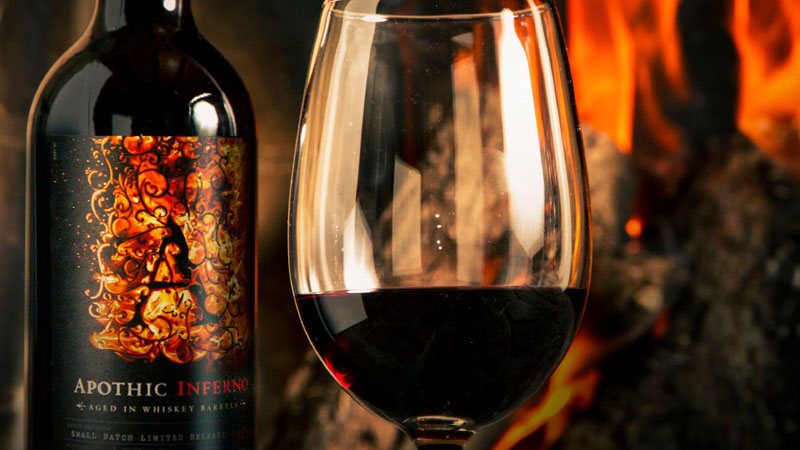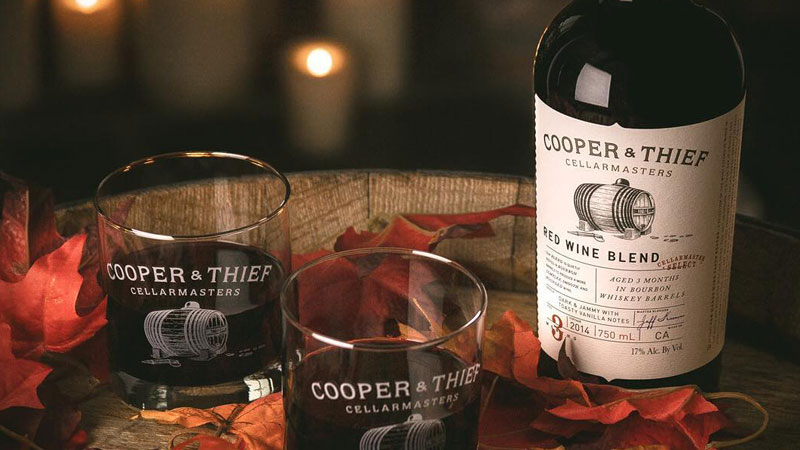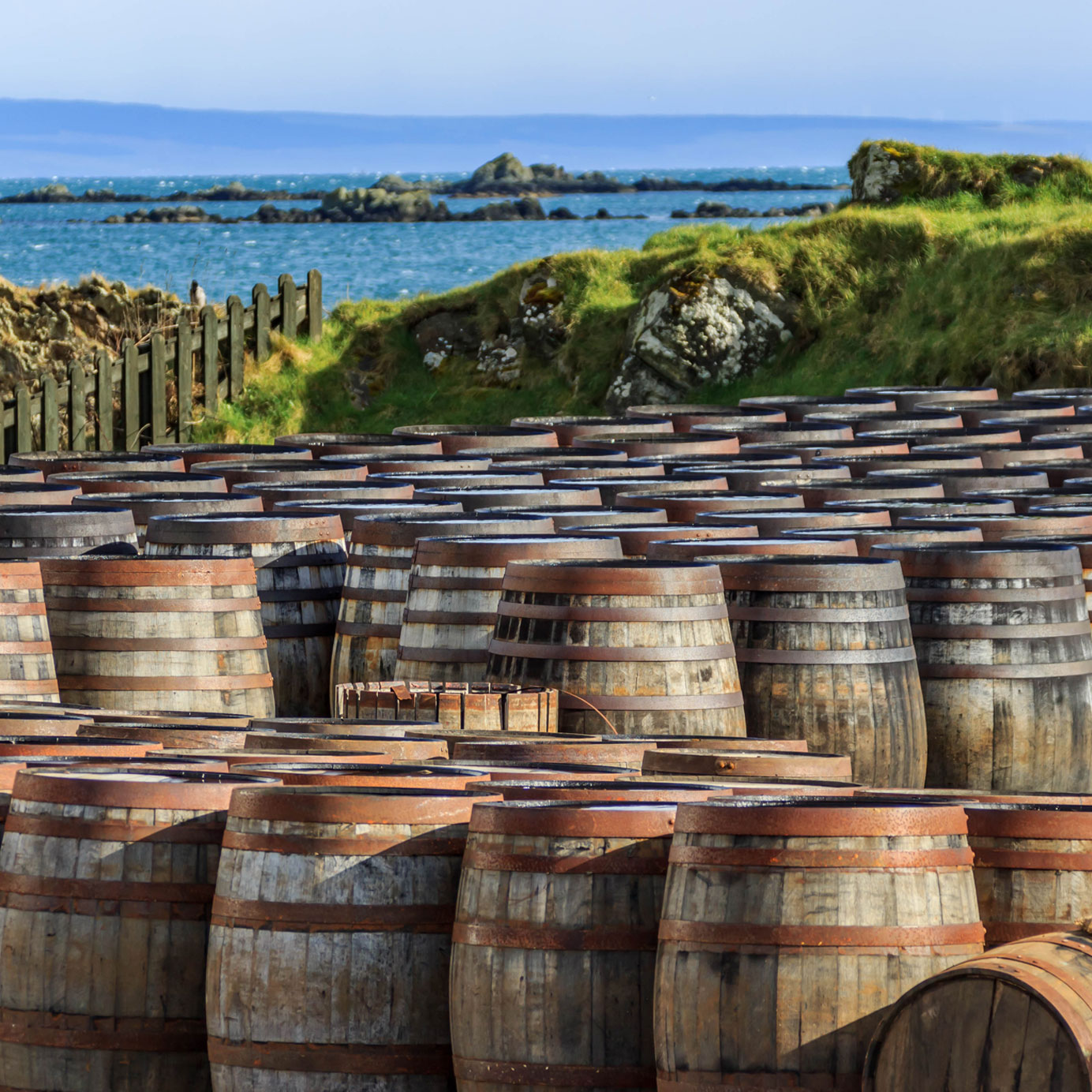
Bob Blue, Fetzer Vineyards’ winemaker and the unofficial baron of bourbon barrel-aged wines, famously describes his creation as a product of thrifty necessity. “I distinctly remember in the early ‘80s that getting French oak for wine was a big deal,” Blue is frequently quoted as saying. “Since there wasn’t a ton of capital, we used bourbon barrels.”
Fetzer’s bourbon-barrel-aged Zinfandel, 1000 Stories, debuted in 2014. In the five years since, production has skyrocketed from 5,000 9-liter cases to more than 140,000 annually. “We continue to see strong double-digit growth,” Rachel Newman, the brand’s marketing director, writes VinePair in an email.
The success of this product is not a fluke, nor is it alone. The spirits-barrel-aged category earned more than $91 million in 2018, up from $800,000 in 2015.
Every major American wine brand has a line aged in spirits barrels. Gallo entered the sector with Apothic Inferno in 2016. Constellation released a bourbon-barrel-aged Robert Mondavi Private Selection Cabernet Sauvignon the same year, and launched Cooper & Thief, a dedicated spirits-barrel-aged brand, in March 2017.
Terlato owns The Federalist, The Wine Group makes Stave and Steel, and Treasury Wine Estates offers a line of bourbon-barrel-aged wines through its Beringer Bros. brand. Even Sam’s Club is enjoying a slice of the pie with Batch No. 198 Cabernet Sauvignon Bourbon Barrel Aged.
“We had just five labels [of spirits-barrel-aged wines] a year ago,” Mike Osborn, Wine.com founder, says. “Today we’re selling 20.”

At this point, those who look down on the category might argue these aren’t “real” wines. They’d be right. Everything from the taste, to serving vessel, to packaging, to promotion moves these beverages as far from that thing stuffy people like to call “wine” as possible.
And so it’s not wine, at least not in a traditional or recognizable way. The thing is, that’s exactly why everyone making and buying it likes it so much.
Spirits-barrel-aged wines don’t taste like the whiskeys or rums that previously occupied their casks, nor do they taste like most Zinfandel and Cabernet Sauvignon. Charred oak and smoky notes dominate both nose and palate, while rich berry compote and sweet vanilla are a distant and very faint afterthought.
Texturally, their tannins are so well integrated they’re practically unnoticeable. It makes for an extremely easy-drinking experience, despite the fact bottles regularly approach and often hit the 16-percent ABV mark. (It’s quite possible that someone buying a bottle of spirits-barrel-aged wine would want its ABV on the higher side, especially if they traditionally drink liquor.)
We’re meant to appreciate these nuances in a non-traditional manner. The Federalist created a “handcrafted” glass for its bourbon-barrel-aged line in 2018, which appears to be a standard rocks glass commonly used for sipping high-proof spirits.
On Stave and Steel’s website, a denim-clad model sits atop a pile of charred wood and a large rusty chain (awkward!) enjoying a glass of the brand’s red blend. He, too, sips from a rocks glass.
The physical bottles themselves also break from tradition. O’Neil Family Vineyards-owned EXITUS delivers its red blend in clear glass bottles. “We don’t hide behind tinted glass,” the brand writes on its website. “Why should you have to wait until your first pour to experience the rich crimson hue of our bourbon barrel aged blend?”
Cooper & Thief’s whiskey-barrel-aged line arrives in short, stocky versions of classic Bordeaux bottles, while Beringer Bros. is the most blatant at attempting to look like a spirit: Its bottles have a pronounced bulge on the neck, a style closely attributed to Scotch whisky.
Labels, too, are noticeably brown-liquor-inspired. Oak-aging statements, traditionally confined to the back of wine bottles, prominently feature on Cooper & Thief’s labels. It’s just that the bold number in red is a “3,” not a 10 or a 12, and it’s months, not years of aging the label’s proclaiming.

According to the websites of these producers, if you want to sell someone a spirits-barrel-aged wine, apparently all you have to do is bombard them with images of fire, barrels, and heavily tattooed men. And if you want to really speak to them, ditch traditional terminology like tannins and terroir, and replace them with words that evoke a sense of rebellion and star-spangled pride.
EXITUS claims to be “bold and fearless,” while “born from mischief” Cooper & Thief “challenges tradition” and “celebrates doing things differently.” These products are not made, they’re “crafted” — The Federalist apparently does so “with the same rebellious spirit that created a nation.” Those tasked with doing so are not winemakers, they’re “cellarmasters” and “winesmiths.”
“I definitely feel that bourbon-barrel-aged wines are a great introduction for those that have traditionally preferred other types of alcohol, like spirits,” Jason Dodge, Robert Mondavi Private Selection’s senior director of winemaking, says.
Jeff Kasavan, Cooper & Thief’s cellarmaster, agrees. “Bourbon barrel-aged wines are a great way for spirits and beer lovers to think differently about wine and explore the category by starting with a wine influenced by flavors they already love,” he says.
Meanwhile, the wines’ high alcohol content suits “those who are looking for something that blurs the line between spirits and wine,” Kasavan says.
It’s clear who these brands are targeting. Who’s buying is slightly less certain.
In an email to VinePair, an EXITUS representative wrote that, according to its research, “the bourbon barrel-aged category was most appealing to a younger (24-45-year-old), more affluent consumer.”
This is inconsistent with data provided by Wine.com. Baby Boomers and Gen-X account for two-thirds of the spirits-barrel-aged wine sold on the online platform.
“Whereas Millennials make up the largest share of our overall customer base, in this category, their parents seem to be making the difference,” Osborn says.
Wine snobs of all ages are unmoved. One writer tweeted that not only is spirits-barrel-aging a “marketing gimmick,” it’s also a great way to “mask the flaws of sub-standard fruit.” The tweet alludes to the fact that charcoal from heavily toasted spirits barrels could serve as a fining agent and fix faults like bad odors. “It’s like putting lipstick on a pig..” he writes. “It’s still a pig..”
The category’s legitimacy is beside the point, though. Yes, these wines and their branding are pretty one-note. And sure, fans might never “graduate” to “real” wines. The large corporations making these wines hardly care, though, and might not want drinkers to move on to other styles.
None of the category’s seven most popular wines retails for less than $15 a bottle. The Federalist sells for an average price of $22, while Exitus has a $25 average. Cooper & Thief’s entry-level blend starts even higher, at $30, and its premium Cab sells for $60.
Spirits-barrel-aged wines are marketed as everything and anything but fermented grape juice so that, if drinkers of this style do start to spend more money on bottles, it will most likely be vertically within the category, rather than on “traditional” wines.
So if the shade of lipstick on this particular pig’s mouth offends you, ask yourself: Is it you or the pig that has a problem?
